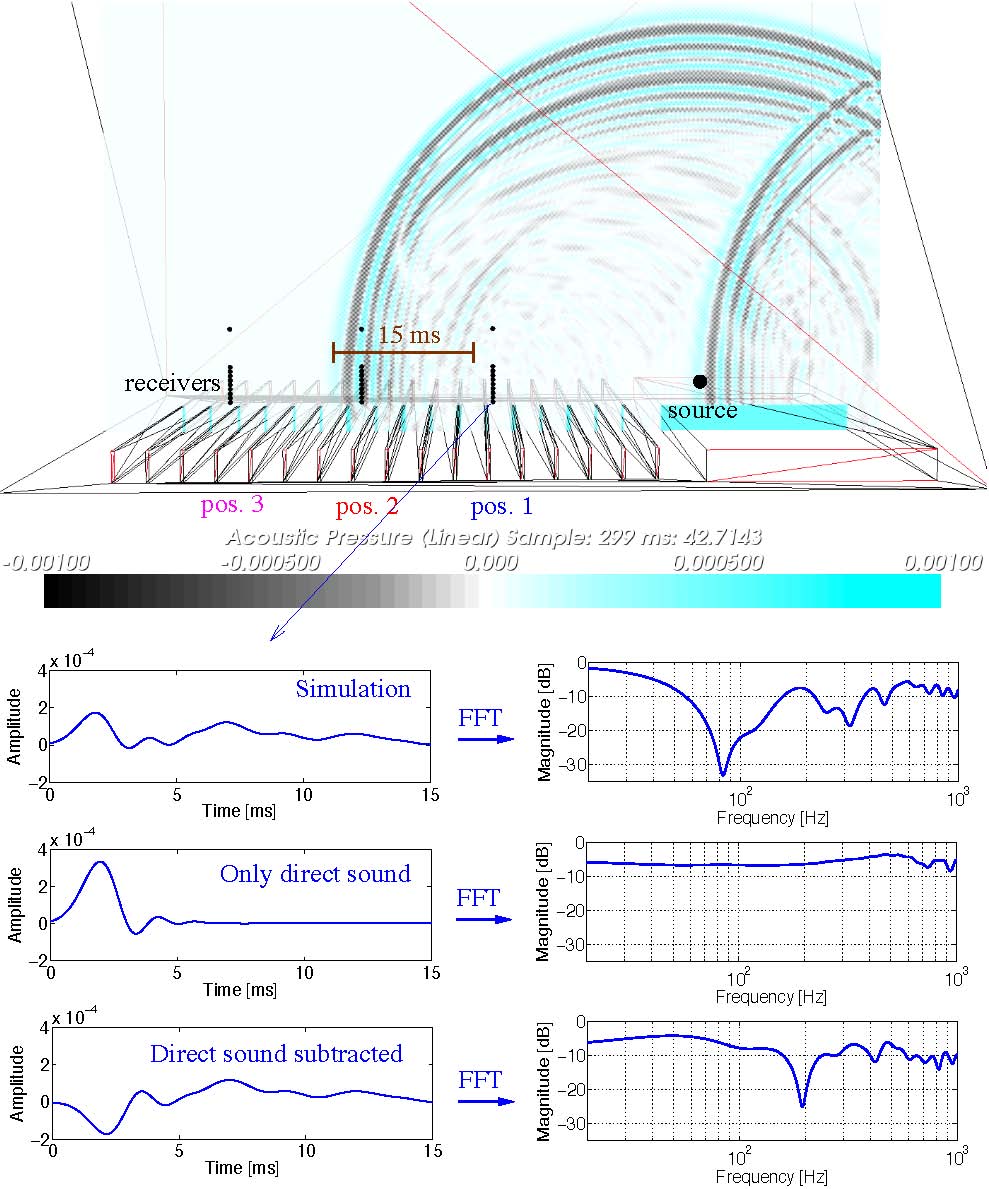- Details
- Published: 09 January 2013
The seat-dip effect attenuates low frequencies of the direct sound and early lateral reflections due to the sound passing at near grazing incidence over audience seating. The seat-dip effect includes several phenomena due to the wave nature of sound, such as diffraction and scattering. The seat-dip effect has been studied in real concert halls [1-5], in scale models [1-3,5], via theoretical models [5,7], and wave-based modelling techniques [8-10].
The effect has been known for over 50 years. The main conclusions of the two fundamental articles [1,2] describing the effect are:
- The rows of seats spread the low frequency sound energy in time, thus acting as a sound energy storing mechanism.
- The frequency of maximum attenuation (typically between 100-300 Hz) depends on the height of the rows rather than on their spacing. The narrow band maximum attenuation is caused by a vertical resonance between the rows.
- If the lower part of the seat is removed in order to create an underpass beneath the seats, the maximum resonant frequency is shifted upwards in frequency.
- There is also considerable attenuation at a wider frequency range (up to 1 kHz), most probably due to the diffraction from the seat tops.
- The attenuation does not depend markedly on the absoption of the seats. In addition, the attenuation hardly changes if the seats are occupied.
The attenuation can be reduced and shifted in frequency. For example, the main attenuation frequency decreases when the angle of incidence increases [3]. Thus, a high stage or an inclined audience area allow to tune the maximum attenuation to lower frequencies. In addition, adding Helmholtz resonators or vent boxes on the floor below the seats decrease the attenuation since they absorb a part of the sound that is delayed due to seat rows [4].
Research on the seat-dip effect in Aalto
The study of the seat-dip effect is one of the modeling applications of the finite-difference time-domain methods developed by the Virtual Acoustics team. The modeling makes it possible to study the seat reflections without the presence of other reflections. Based on the modeling results, it is confirmed that the seat-dip effect rises from the delayed sound interfering destructively with the direct sound [10]. In addition, the delayed sound is shown to be directed upwards. Based on the analysis of six concert halls measured by the Virtual Acoustics team, the seat-dip attenuation is best corrected in halls that provide the most lateral reflections [6].
Perceptual evaluation of the seat-dip effect rather an undeveloped field, and the research in Aalto aims at unraveling this. The seat-dip effect is linked with the quality of sound in concert halls, and the effect seems in some cases to render the sound muddy, and to obscure the articulation of bass instruments [10].
References
[1] T. Schultz and B. Watters, “Propagation of sound across audience seating,” Journal of the Acoustical Society of America, vol. 36, no. 5, pp. 885–896, 1964.
[2] G. Sessler and J. West, “Sound transmission over theatre seats,” Journal of the Acoustical Society of America, vol. 36, no. 9, pp. 1725–1732, 1964.
[3] J. Bradley, “Some further investigations of the seat dip effect,” Journal of the Acoustical Society of America, vol. 90, no. 1, pp. 324–333, 1991.
[4] W. Davies and Y. Lam, “New attibutes of seat dip attenuation,” Applied Acoustics, vol. 41, no. 1, pp. 1–23, 1994.
[5] D. Takahashi, “Seat dip effect: The phenomena and mechanism,” Journal of the Acoustical Society of America, vol. 102, no. 3, pp. 1326–1334, 1997.
[6] J. Pätynen, S. Tervo, and T. Lokki, “Analysis of concert hall acoustics via visualisations of time-frequency and spatiotemporal responses,” Journal of the Acoustical Society of America, vol. 133, no. 2, pp. XX-XX, 2013.
[7] Y. Ando, M. Takaishi, and K. Tada, “Calculations of the sound transmission over theater seats and methods for its improvement in the low-frequency range,” Journal of the Acoustical Society of America, vol. 72, no. 2, pp. 443–448, 1982.
[8] J. LoVetri, D. Mardare, and G. Soulodre, “Modeling of the seat dip effect using the finite-difference time-domain method,” Journal of the Acoustical Society of America, vol. 100, no. 4, pp. 2204–2212, 1996.
[9] W. Davies and T. Cox, “Reducing seat dip attenuation,” Journal of the Acoustical Society of America, vol. 108, no. 5, pp. 443–448, 2000.
[10] T. Lokki, A. Southern, and L. Savioja, “Studies on seat dip effect with 3D FDTD modeling,” in Proceedings of Forum Acusticum, Aalborg, Denmark, 2011.
[11] W. Davies, T. Cox, and Y. Lam, “Subjective perception of seat dip attenuation,” Acta Acustica united with Acustica, vol. 82, pp. 784–792, 1996.




